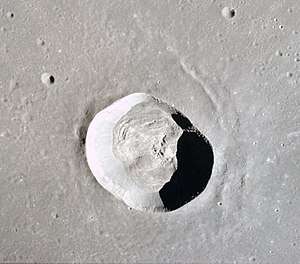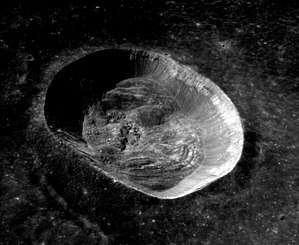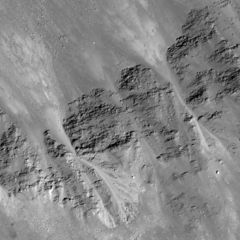Dawes (lunar crater)
 | |
| Coordinates | 17°12′N 26°24′E / 17.2°N 26.4°ECoordinates: 17°12′N 26°24′E / 17.2°N 26.4°E |
|---|---|
| Diameter | 18 km |
| Depth | 2.3 km |
| Colongitude | 334° at sunrise |
| Eponym | William R. Dawes |
Dawes is a lunar impact crater, named after the British astronomer William Rutter Dawes, and which is located in the wide straight between Mare Serenitatis and Mare Tranquilitatis. About 70 km southwest is the larger crater Plinius, other nearby prominent craters include Beketov nearly 75 km to the east and nearly to the southeast is Jansen. To the northeast is the Mons Argaeus mountain rise.

Its diameter is 18 km long and is 2,300 meters deep. The area is more than 225 km² and the perimeter is over 50 km.

Description
This is a circular crater with a sharp rim that has a slightly flattened oval perimeter. It has a slight central rise, and a somewhat darker floor that is nearly covered in overlapping swirl-like deposits. Much of the deposits are slumped or fall-back material. The inner walls are steep and free from impact erosion. Northeast of Dawes is a rille known as Rima Dawes, it lies next to Catena Brigitte to the northeast. The rille name was approved by the IAU in 1985.
Detailed examination of this crater have located what appear to be alcoves and channels along the inner rim. It is hypothesized that micrometeorite impacts along the rim trigger dry landslides, which produce a gully-like appearance. A similar phenomenon may be responsible for gully-like features along the inner rim of some Martian craters.[1]
See also
Notes
- ↑ Stiles, Lori (2006-03-10). "Water May Not Have Formed Mars' Recent Gullies". University of Arizona. Retrieved 2015-08-04.
References
- Andersson, L. E.; Whitaker, E. A. (1982). NASA Catalogue of Lunar Nomenclature. NASA RP-1097.
- Blue, Jennifer (July 25, 2007). "Gazetteer of Planetary Nomenclature". USGS. Retrieved 2007-08-05.
- Bussey, B.; Spudis, P. (2004). The Clementine Atlas of the Moon. New York: Cambridge University Press. ISBN 978-0-521-81528-4.
- Cocks, Elijah E.; Cocks, Josiah C. (1995). Who's Who on the Moon: A Biographical Dictionary of Lunar Nomenclature. Tudor Publishers. ISBN 978-0-936389-27-1.
- McDowell, Jonathan (July 15, 2007). "Lunar Nomenclature". Jonathan's Space Report. Retrieved 2007-10-24.
- Menzel, D. H.; Minnaert, M.; Levin, B.; Dollfus, A.; Bell, B. (1971). "Report on Lunar Nomenclature by the Working Group of Commission 17 of the IAU". Space Science Reviews. 12 (2): 136–186. Bibcode:1971SSRv...12..136M. doi:10.1007/BF00171763.
- Moore, Patrick (2001). On the Moon. Sterling Publishing Co. ISBN 978-0-304-35469-6.
- Price, Fred W. (1988). The Moon Observer's Handbook. Cambridge University Press. ISBN 978-0-521-33500-3.
- Rükl, Antonín (1990). Atlas of the Moon. Kalmbach Books. ISBN 978-0-913135-17-4.
- Webb, Rev. T. W. (1962). Celestial Objects for Common Telescopes (6th revised ed.). Dover. ISBN 978-0-486-20917-3.
- Whitaker, Ewen A. (1999). Mapping and Naming the Moon. Cambridge University Press. ISBN 978-0-521-62248-6.
- Wlasuk, Peter T. (2000). Observing the Moon. Springer. ISBN 978-1-85233-193-1.
External links
| Wikimedia Commons has media related to Dawes (lunar crater). |
| Wikimedia Commons has media related to Rima Dawes. |
- Dawes at the Moon Wiki
- Rima Dawes at the Moon Wiki
- High resolution view from Apollo 15 (Figure 144 of Apollo Over the Moon: A View from Orbit (online version) (NASA SP-362), 1978)
- Lunar Orbiter 5 image 070, L&PI
- LTO-42C3 Dawes — L&PI topographic map
- LROC page: Dawes
Related article
- Wood, Chuck (August 4, 2012). "Rim Ash?". Lunar Photo of the Day. Retrieved August 16, 2017.
